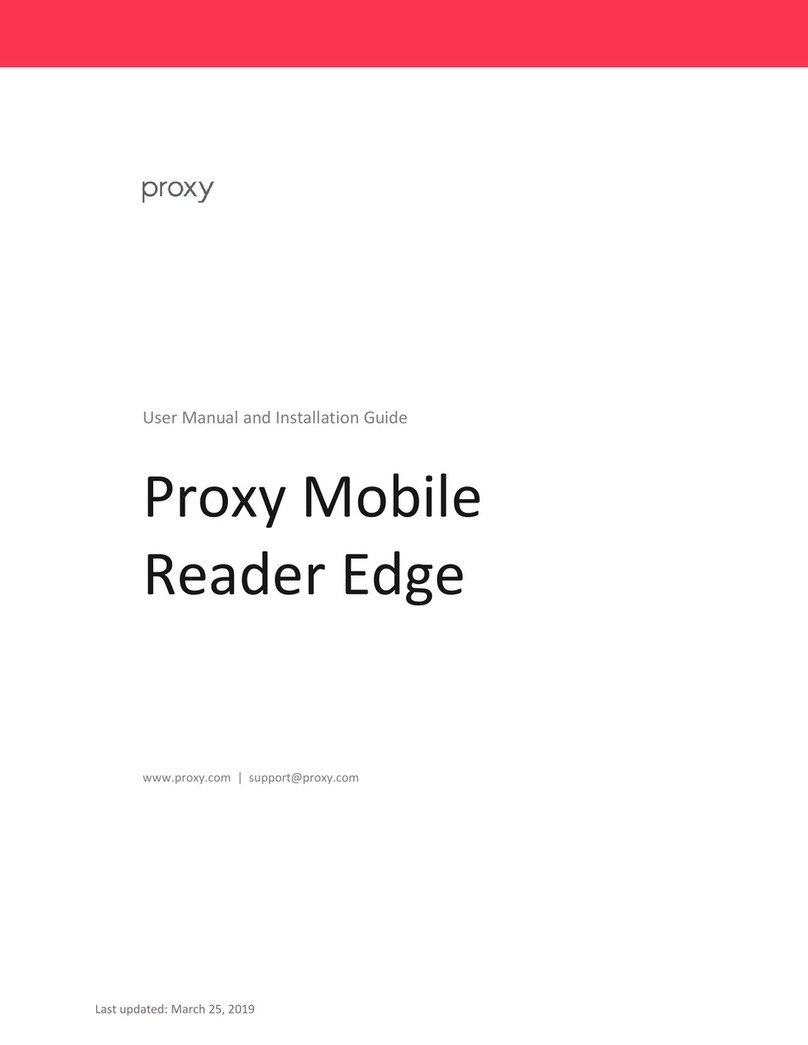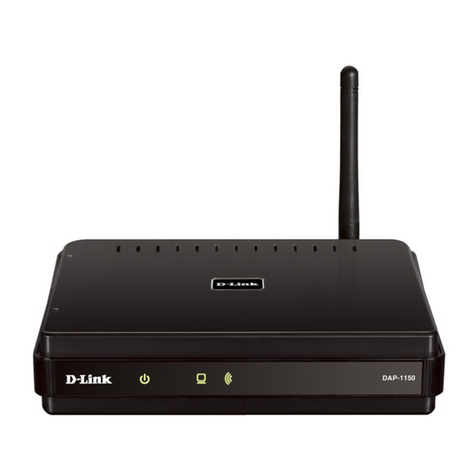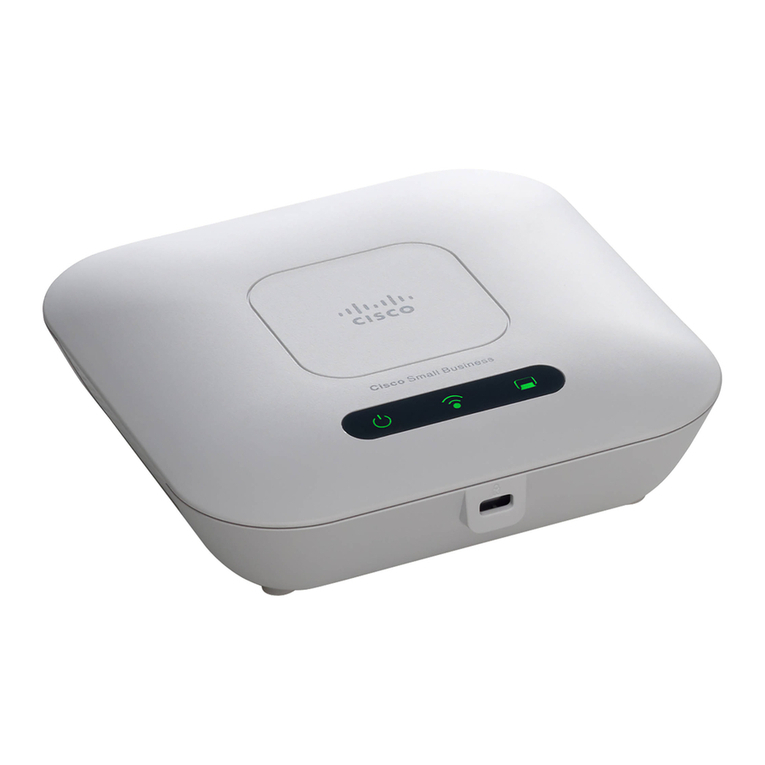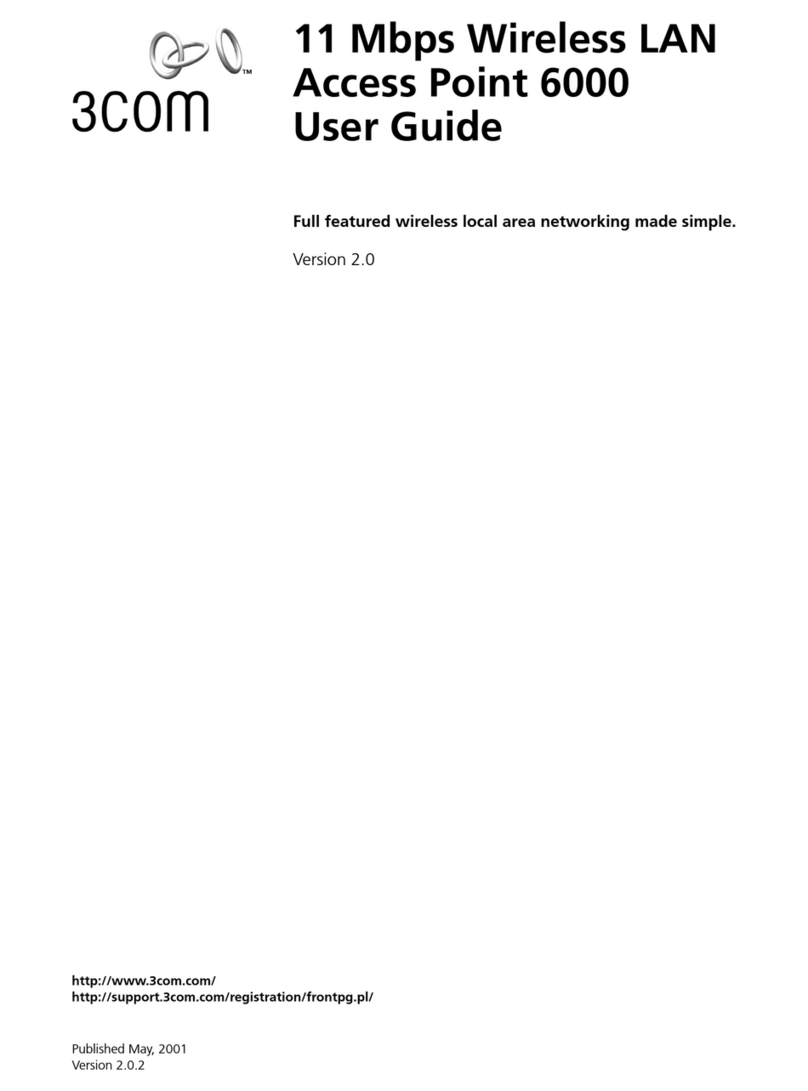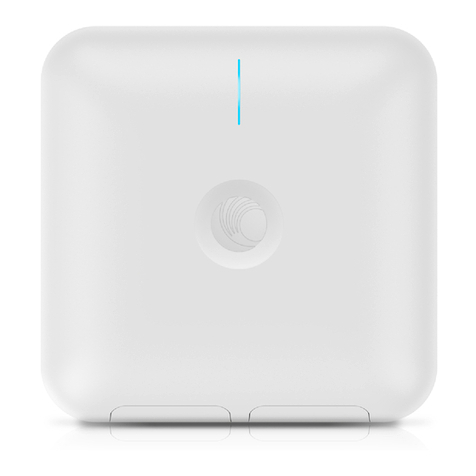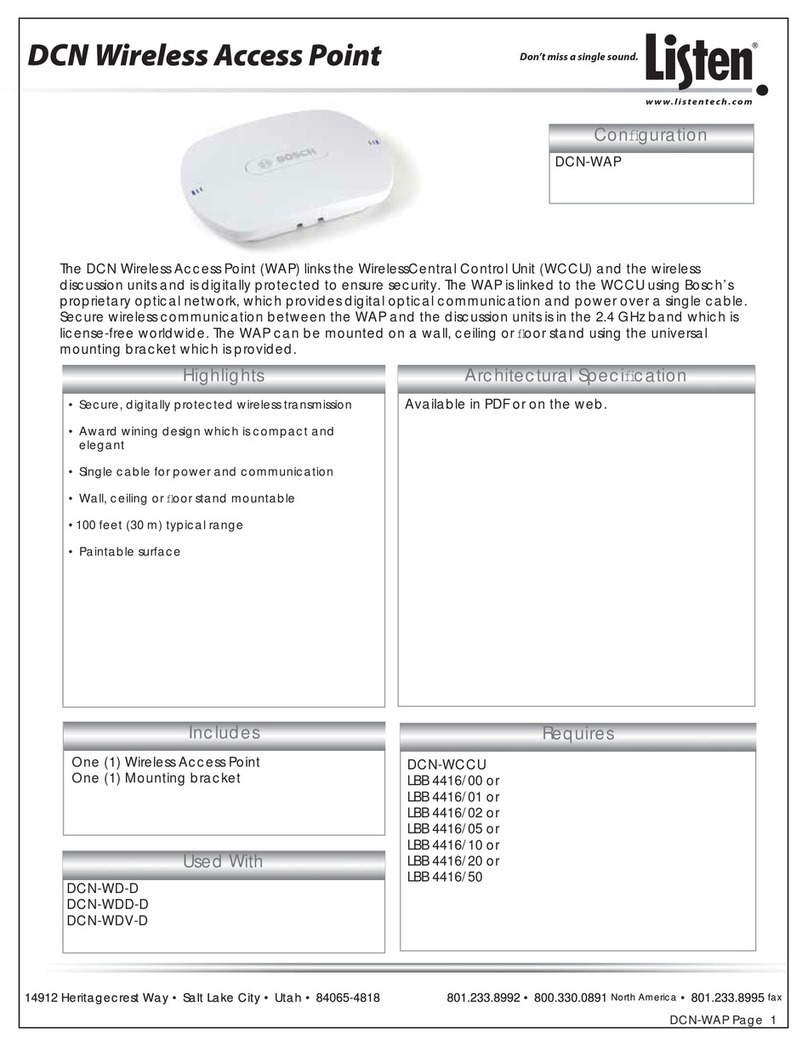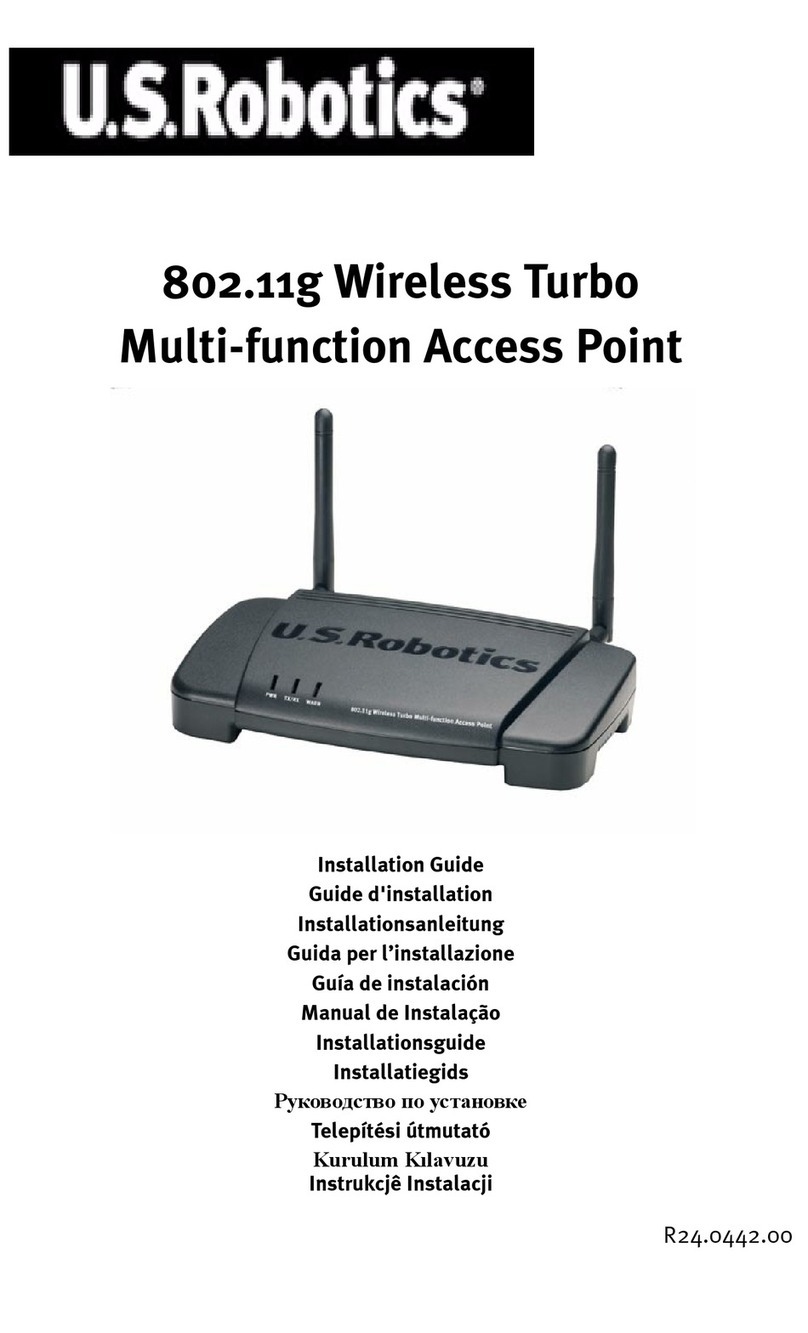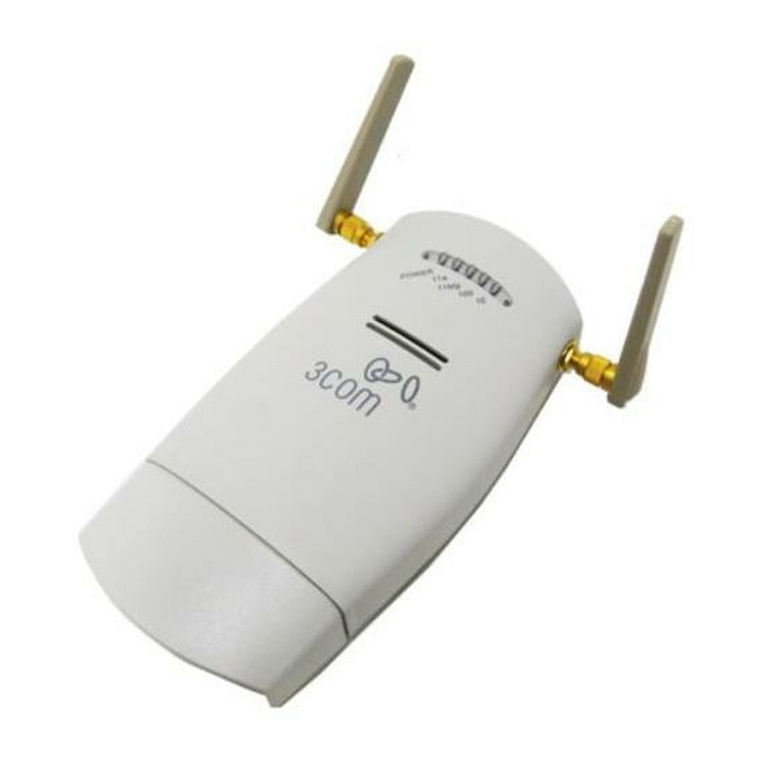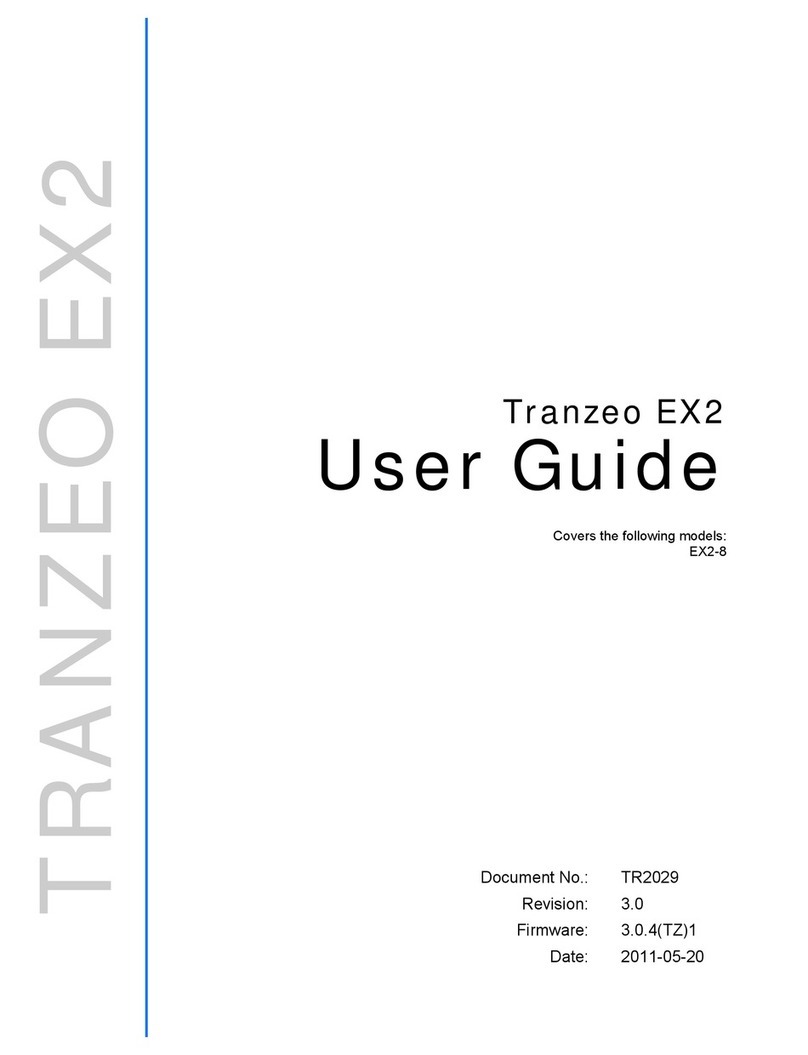Proxy Mobile Reader Pro User manual

V 1.5
Proxy Technologies, Inc.
User manual
For
Proxy Reader Pro
(Mullion)
Document number: PRXY-1001UM
Confidential

User Manual v1.6 2
Printed copies of this document are uncontrolled
Proxy Reader User Manual
Version HIstory:
Date
Version
Description
Author
11/10/2017
1.0
Initial Draft
Andrew Tam
12/14/2017
1.1
Specs finalized, Line Drawings updated
Andrew Tam
01/28/2018
1.2
Updated Table 4
Andrew Tam
7/31/2018
1.3
Updated WEEE, WiFi to IEEE 802.11, RF exp
Andrew Tam
7/31/2018
1.4
Update rf power table FCC / IC / CE
Andrew Tam
8/16/2018
1.5
Power limited Class 2
Andrew Tam
10/15/18
1.6
Update FCC / IC / CE
Andrew Tam

User Manual v1.6 3
Printed copies of this document are uncontrolled
Contents
Proxy Reader User Manual 2
1.0 Introduction 4
2.0 Reader 4
2.1 Functionality 4
2.2 Proxy Reader Mullion Main Housing 4
2.3 Proxy Reader Mullion Wall Plate 5
3.0 Product details 6
4.0 Reader Specifications 7
4.1 Rated current at different operating voltages 7
4.1.1 Rated current for Model 8010 7
5.0 Installation details 8
5.1 Parts List 8
5.2 Recommended Infrastructure 8
5.3 Wiring Information 9
5.3.1 Cable Color codes for Pig Tail Reader 9
5.4 Mounting the Reader 10
5.4.1 Location of mounting holes on wall 10
5.4.2 Reader Installation Steps 10
5.5 Power up and Testing 11
6.0 Certifications 12
6.1 FCC 12
6.2 IC
錯誤
!
尚未定義書籤。
6.3 CE
錯誤
!
尚未定義書籤。
6.4 UL294
錯誤
!
尚未定義書籤。
6.4.1 UL 294 access control performance levels 15

User Manual v1.6 4
Printed copies of this document are uncontrolled
1.0 Introduction
This document details the Physical Access Control Reader Proxy Reader Pro® and its basic
operational and installation procedures. It covers the details of the Mullion form-factor reader.
Model : Proxy Reader Pro : PRXY-MW-1.0 (white version) , PRXY-MK-1.0 (black version)
The reader comes in one variant for interfacing with the control panel
- Standard HF LF BLE IEEE 802.11b/g/n
The reader comes in one variant in functionality
- Standard HF LF BLE IEEE 802.11b/g/n
2.0 Reader
2.1 Functionality
Proxy Reader Pro is a physical access control wireless mobile credential and smart card reader
that can read HF / LF contactless credentials conforming to the following standards: ISO 14443
A & B as well as wireless credentials over BLE. The reader can interface with an access control
system equipped with a Wiegand or RS485 serial interface. The reader consists of the following
main parts.
2.2 Proxy Reader Pro Mullion Main Housing

User Manual v1.6 5
Printed copies of this document are uncontrolled
2.3 Proxy Reader Pro Mullion Wall Plate

User Manual v1.6 6
Printed copies of this document are uncontrolled
3.0 Product details
Model Name : Proxy Reader Pro / PRXY-MW-1.0 / PRXY-MK-1.0
Device Type : RFID reader, 13.56MHz (HF) / 125 KHz (LF) /
Mobile Credential: 2.4GHz (BLE)
Physical Access control Reader (accessory equipment)
Type of equipment : Sealed Reader
Suitable for Indoor use and
Outdoor use –PRXY-MW-1.0 and PRXY-MK-1.0
Interface Type : Pigtail Cable (11 Core + Drain)
Electrical Rating : 6V - 16V DC , 0.5A, 8W (Max)
Communication protocol : Wiegand, RS485 (2wire - Half Duplex), BLE, IEEE
802.11b/g/n
Credential Type: RFID: Standard 26-Bit
BLE: Default 32-Bit
Transmission Technology: WIEGAND, OSDP, OSDP2
* Communication via Wiegand was evaluated by UL and serves as the interface between the
reader and panel. Communication via RS485, OSDP or Ethernet was not evaluated by UL
*IEEE802.11b/g/n communications are used for non-critical operations (OTA, backhaul, etc)
RF Exposure Information
This device has been tested and meets applicable limits for Radio Frequency (RF) exposure.
This equipment should be installed and operated with minimum distance 20 cm between the
radiator & your body.

User Manual v1.6 7
Printed copies of this document are uncontrolled
4.0 Reader Specifications
Model
Operating Voltage
Current Rating
Operating Temp.
Proxy Reader Pro //
PRXY-MW-1.0 //
PRXY-MK-1.0
HF LF BLE IEEE
802.11b/g/n
6V - 16V DC
0.5A
-35C to +66C , 85% RH
There shall be no connections made to the RS-485 interface ( RS485+ and RS485-) for
UL installations
Note:
- Standby Power is not provided by the Card Readers. The Standby Power Level is
dependent on the external power source connected to the Card Reader.
- For RS485 use 24 AWG twisted pair cable with a shunt capacitance of 16 pF per foot
and 100 ohm characteristic impedance (option: Category 5 shielded twisted pair (STP))
4.1 Rated current at different operating voltages
4.1.1 Rated current for PRXY-MW-1.0 & PRXY-MK-1.0
- All wiring or cables to the Card Readers shall be the shielded type.
Voltage (V)
Average Current (mA)
Peak Current (mA)
6
180
260
8
162
248
10
126
200
12
102
165
14
95
135
16
80
125

User Manual v1.6 8
Printed copies of this document are uncontrolled
5.0 Installation details
Wiring methods shall be in accordance with the National Electrical Code (ANSI/NFPA70),
local codes, and the authorities having jurisdiction.
5.1 Parts List
○Proxy Reader - 1
○Security Screw –#6 - 32 x 3/8” -- 1 Nos
○Mounting Screws -- #6-32 x 1” -- 2 Nos
○Nylon anchor plugs -- #6 Size x 1” -- 2 Nos
5.2 Recommended Infrastructure
○All cabling and wiring shall be UL Listed and/or UL Recognized
○All readers shall be powered by UL listed power-limited power supply, or power-
limited output from UL listed control panel
○There shall be no connections made to the RS-485 interface ( RS485+ and
RS485-) for UL installations
○Cable Wiegand - 22AWG Shielded cable. ( Cable P No : ALPHA WIRE, P/N
1299/10C)
○Cable RS485 - RS485 for 1000m** (4000 ft) 24AWG STP
○Linear DC PS
○6 - 16 V, 1A min.
** Tested in lab conditions up to 115Kbaud

User Manual v1.6 9
Printed copies of this document are uncontrolled
5.3 Wiring Information
5.3.1 Cable Color codes for Pig Tail Reader
Red
+VDC 12V (nominal)
Black & White
Ground
N,
Green
Wiegand Data 0
White
Wiegand Data 1
Orange
Green LED
Yellow
Buzzer
Blue
Hold
Brown
Red LED
Grey
RS485 -
Pink
RS485 +
Violet
Tamper Output
Black / Drain
Shield Ground
** For Wiring diagrams and termination points please see your control panel user
manual. Installations will differ between access control panel manufacturers.
Caution:
During Wiring make sure that the +VDC lines does not make contact with any other cables, as it might
affect reader functionality/ cause damage to the reader.

User Manual v1.6 10
Printed copies of this document are uncontrolled
5.4 Mounting the Reader
5.4.1 Location of mounting holes on wall
5.4.2 Reader Installation Steps
●Make two holes on the wall as per the image above corresponding to the type of reader.
●Insert the nylon screw plugs into the wall.
●Connect the wires as per the Table in Section 5.3.1
●Proxy Reader® Mullion Wall Plate is to be secured onto the wall using the Screws (A)
●Proxy Reader® Mullion Main Housing can be installed onto Wall Plate
●Secure the Main Housing to the wall plate using Security Screw (B)

User Manual v1.6 11
Printed copies of this document are uncontrolled
5.5 Power up and Testing
1 Turn power on
●Indicator Light (top of housing) powers on and turns RED
●Branding LEDs turn on (Proxy Logo Displayed)
2 Present a card
●Access Granted: The Indicator LED blinks green, and a short Beep is emitted
●Access Denied: Dependant on Access controller configuration
3 Present a Phone with Proxy Pass App Enabled
●Access Granted: The Indicator LED blinks green, and a short Beep is emitted
●Access Denied: Dependant on Access controller configuration
This is the default reader behavior.

User Manual v1.6 12
Printed copies of this document are uncontrolled
6.0 Certifications
6.1 FCC
Tune up power table BLE / WLAN
-Each product is programmed with the pre-defined RF parameters
-Each product RF power level is measured to ensure the power level not exceeding the
target power level, in a fully calibrated setup.
-The user has no possibility to change these settings later on
Please find below the Maximum Transmit Power for production units:
<For Type1LD>
Band / Mode Average Power (dBm)
LE
GFSK
Bluetooth 7
Band / Channel / Frequency (MHz) IEEE 802.11 Average Power (dBm)
11b
11g
HT20
2.4GHz WLAN
17
17
17
<For XRBH-1>
Band / Mode
Average Power (dBm)
LE
GFSK
Bluetooth 5
This equipment has been tested and found to comply with the limits for a Class B digital device,
pursuant to part 15 of the FCC Rules. These limits are designed to provide reasonable
protection against harmful interference in a residential installation. This equipment generates
uses and can radiate radio frequency energy and, if not installed and used in accordance with
the instructions, may cause harmful interference to radio communications. However, there is no
guarantee that interference will not occur in a particular installation. If this equipment does
cause harmful interference to radio or television reception, which can be determined by turning
the equipment off and on, the user is encouraged to try to correct the interference by one or
more of the following measures:
—Reorient or relocate the receiving antenna.
—Increase the separation between the equipment and receiver.

User Manual v1.6 13
Printed copies of this document are uncontrolled
—Connect the equipment into an outlet on a circuit different from that to which the receiver is
connected.
—Consult the dealer or an experienced radio/TV technician for help.
RF Exposure Information
This device has been tested and meets applicable limits for Radio Frequency (RF) exposure.
This equipment should be installed and operated with minimum distance 20 cm between the
radiator & your body.
Information to user
This device complies with part 15 of the FCC Rules. Operation is subject to the following two
conditions: (1) This device may not cause harmful interference, and (2) this device must accept
any interference received, including interference that may cause undesired operation.
Changes or modifications not expressly approved by Proxy Technologies, Inc. could void the
user's authority to operate the equipment.
6.2 IC
This Class B digital apparatus complies with Canadian ICES-003.
This device complies with Industry Canada licence-exempt RSS standard(s).
Operation is subject to the following two conditions:
(1) This device may not cause interference
(2) This device must accept any interference, including interference that may cause undesired
operation of the device.
Le présent appareil est conforme aux CNR d’Industrie Canada applicables aux
appareils radio exempts de licence. L’exploitation est autorisée aux deux conditions
suivantes:
(1) l’appareil ne doit pas produire de brouillage, et
(2) l’utilisateur de l’appareil doit accepter tout brouillage radioélectrique subi, même si le
brouillage est susceptible d’en compromettre le fonctionnement.”
RF Exposure Information
This device has been tested and meets applicable limits for Radio Frequency (RF)
exposure.

User Manual v1.6 14
Printed copies of this document are uncontrolled
This equipment should be installed and operated with minimum distance 20 cm
between the radiator & your body.
Informations d’exposition RF
Cet appareil a été testé et répond aux limites applicables en matière d’exposition aux
radiofréquences (RF).
Cet équipement doit être installé et utilisé avec une distance minimale de 20 cm entre le
radiateur et votre corps.
6.3 CE
Tune up power table BLE / WLAN
-Each product is programmed with the pre-defined RF parameters
-Each product RF power level is measured to ensure the power level not exceeding the
target power level, in a fully calibrated setup.
-The user has no possibility to change these settings later on
Please find below the Maximum Transmit Power for production units:
<For Type1LD>
Band / Mode Average Power (dBm)
LE
GFSK
Bluetooth
8.2
Band / Channel / Frequency (MHz) IEEE 802.11 Average Power (dBm)
11b
11g
HT20
2.4GHz WLAN
9.3
9.3
9.1
<For XRBH-1>
Band / Mode Average Power (dBm)
LE
GFSK
Bluetooth 1.0
Hereby, Proxy Technologies, Inc. declares that the radio equipment type Proxy Reader Pro is in
compliance with Directive 2014/53/EU.
Please scan the barcode on the label to view the user guide.

User Manual v1.6 15
Printed copies of this document are uncontrolled
Waste Electrical and Electronic Equipment (WEEE)
This symbol means that according to local laws and regulations your product and/or its
battery shall be disposed of separately from household waste. When this product reaches its
end of life, take it to a collection point designated by local authorities. Proper recycling of
your product will protect human health and the environment.
Waste Electrical and Electronic Equipment (WEEE)
This symbol means that according to local laws and regulations your product and/or its battery shall be disposed of separately from
household waste. When this product reaches its end of life, take it to a collection point designated by local authorities. Proper
recycling of your product will protect human health and the environment.
6.4 UL294
Communication via Wiegand was evaluated by UL and serves as the interface between the
reader and panel
Communication via RS485 or OSDP is not permitted
All terminals are Power Limited / Class 2 circuits
6.4.1 UL 294 access control performance levels
●Destructive attack : Level I
●Line Security : Level I
●Endurance : Level I
●Standby Power : Level I
Other manuals for Mobile Reader Pro
1
Table of contents
Other Proxy Wireless Access Point manuals
Popular Wireless Access Point manuals by other brands
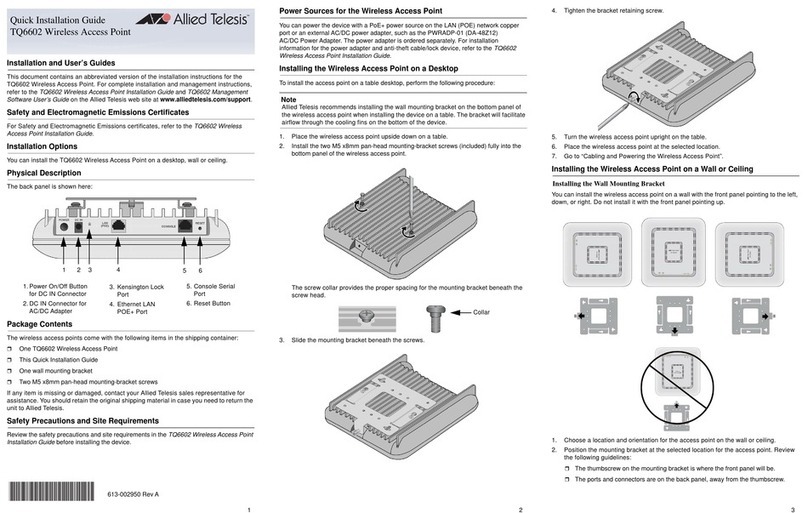
Allied Telesis
Allied Telesis TQ6602 Quick installation guide
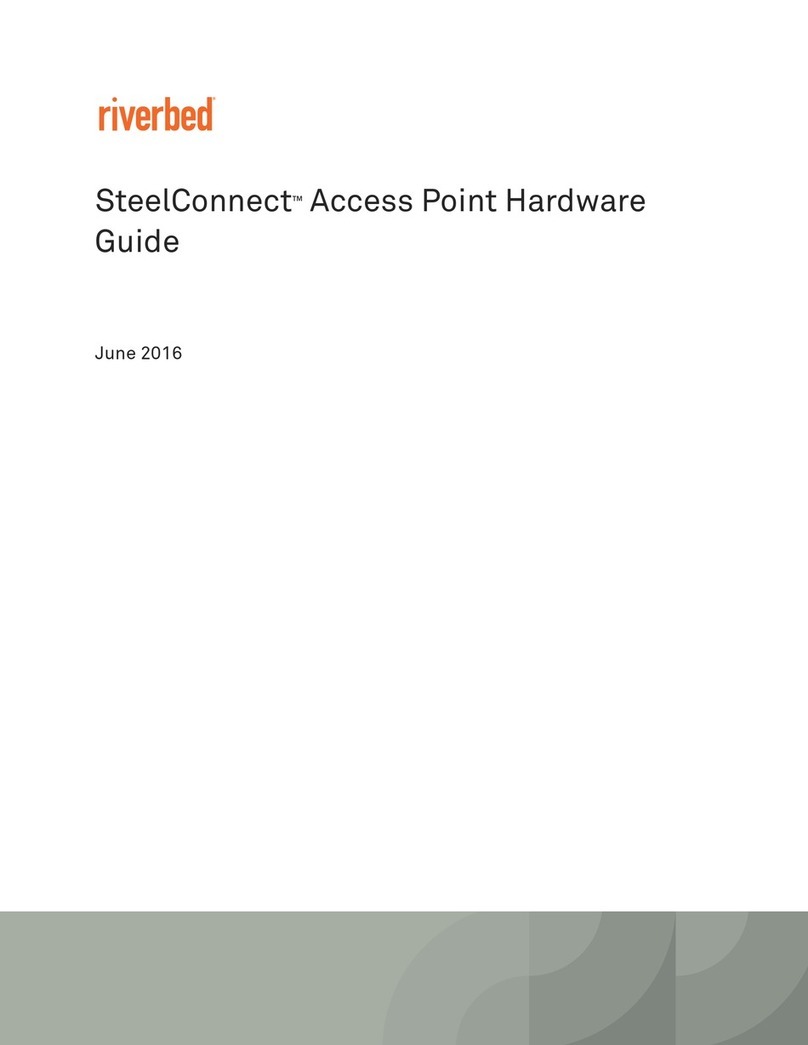
Riverbed
Riverbed SteelConnect SDI-AP3 Hardware guide
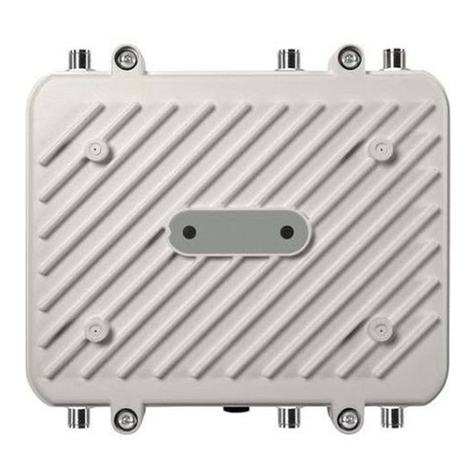
Motorola
Motorola AP-7562 installation guide
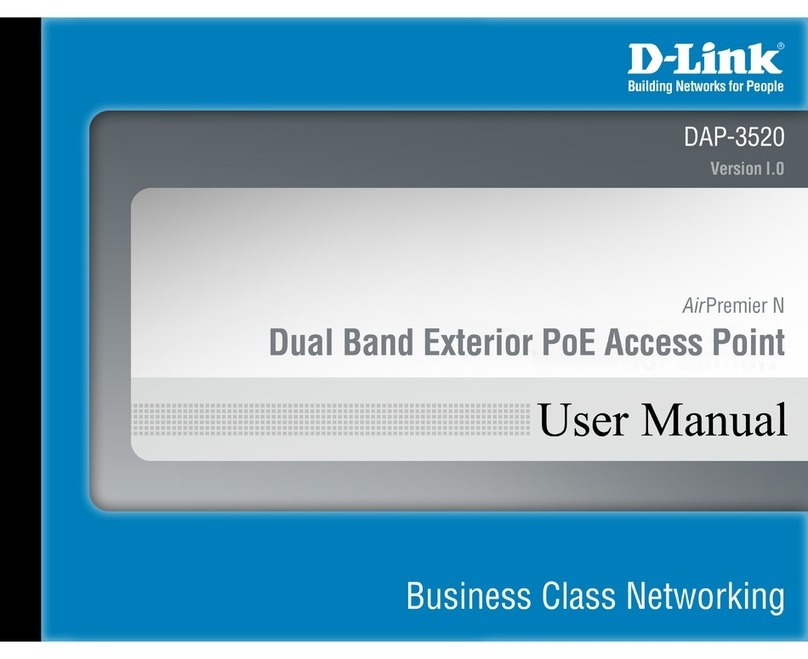
D-Link
D-Link DAP-3520 - AirPremier N Dual Band Exterior PoE Access... user manual

Aruba
Aruba AP-105 installation guide
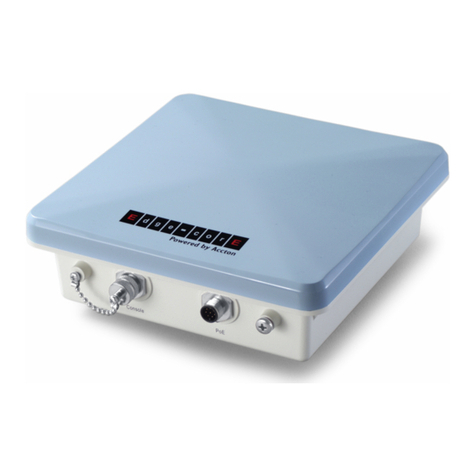
Edge-Core
Edge-Core WA6202A user guide
